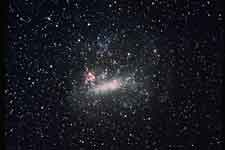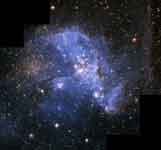|
|
The two Magellanic Clouds are irregular dwarf galaxies, which are members of our Local Group of galaxies. Once they were thought to be orbiting our Milky Way galaxy. However, new research seems to indicate that this is not the case.[1][2]
History

The Large Magellanic Cloud (LMC)
The Magellanic Clouds were certainly known since the earliest times by the ancient Middle Eastern peoples. The first preserved mention of the Large Magellanic Cloud was by Persian astronomer Al Sufi, who in 964, in his Book of Fixed Stars, calls it Al Bakr, the White Ox of the southern Arabs, and points out that while invisible from Northern Arabia and Baghdad, this object is visible from the strait of Bab el Mandeb, at 12°15' Northern latitude.
In Europe, it was the expedition of Ferdinand Magellan that first observed the clouds during the circumnavigation in 1519–1522, as reported by Antonio Pigafetta. However, naming the clouds after Magellan did not become widespread until much later. In Bayer's Uranometria (1603) they are called "Nubecula Maior"[3] and "Nubecula Minor"; even in a 1795 French edition of Flamsteed's star atlas, they are designated as "Le Grand Nuage" and "Le Petit Nuage"[4] (in both cases this means simply "Large cloud" and "Small cloud", in Latin and French correspondingly).

Part of the Small Magellanic Cloud (SMC)
Characteristics
The Large Magellanic Cloud and its neighbor and relative, the Small Magellanic Cloud, are conspicuous objects in the southern hemisphere, looking like separated pieces of the Milky Way to the naked eye. Roughly 21° apart in the night sky, the true distance between them is roughly 75,000 light-years. Until the discovery of the Sagittarius Dwarf Elliptical Galaxy in 1994, they were the closest known galaxies to our own.
Observation, and theoretical evidence suggests that the LMC and SMC have been greatly distorted by tidal interaction with the Milky Way as they orbit around it; streams of neutral hydrogen connect them to the Milky Way and to each other, and both resemble disrupted barred spiral galaxies. (Zeilik) However, their gravity has affected our Galaxy as well, distorting the outer parts of the galactic disk. (Chaisson and McMillan)
The Magellanic Clouds' radial velocity and proper velocity were recently accurately measured by a team from the Harvard-Smithsonian Center for Astrophysics to produce a 3-D velocity measurement that clocked their passage through the Milky Way galaxy in excess of 480km/s (300 miles per second) using input from Hubble Telescope. This unusually high velocity seems to imply that they are in fact not bound to the Milky Way, and many of the presumed effects of the Magellanic Clouds have to be revised.[5]
Aside from their different structure and lower mass, they differ from our Galaxy in two major ways. First, they are gas-rich; a relatively higher fraction of their mass is hydrogen and helium compared to the Milky Way.[6] They are also more metal-poor than the Milky Way; the youngest stars in the LMC and SMC have a metallicity of 0.5 and 0.25 times solar, respectively.[7] Both are noted for their nebulae and young stellar populations, but as in our own Galaxy their stars range from the very young to the very old, indicating a long stellar formation history.(Chaisson and McMillan)
The Large Magellanic Cloud was host galaxy to a supernova (SN 1987A), the brightest observed in over three centuries.
References
- Eric Chaisson and Steve McMillan, Astronomy Today, (Englewood Cliffs: Prentice-Hall, Inc., 1993), p. 550.
- Michael Zeilik, Conceptual Astronomy, (New York: John Wiley & Sons, Inc., 1993), pp. 357–8.
Links
Magellanic Clouds Working Group
|
|

